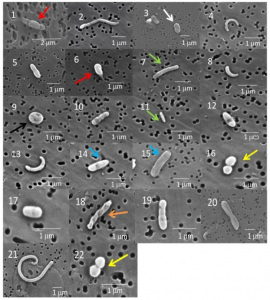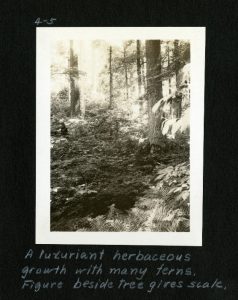Blog Post 2 by Mandi Peterson
“Ice” is the eighth episode of the first season of the American science fiction television series The X-Files, which aired on the Fox network on November 5, 1993. The plot of the episode starts with special Federal Bureau of Investigation (FBI) agents Fox Mulder and Dana Scully investigating the murder suicides of an Alaskan research team. As the episode progresses and the bodies are examined, the FBI agents deduce that the cause of the violent behavior is because the researchers were driven mad by parasitic worms. The worm enters the brain and moves through the body, influencing the behavior of the affected individual towards stress and violence. These parasitic worms were found lying dormant in Alaskan ice caps which were affected by a long distant meteor collision. Upon the harvesting of ice cores to conduct scientific testing, a worm burrowed into each of the two now dead hosts. The worms which are collected and solitarily isolated appear to be aggressive towards one another, even trying to break the glass to attack the other. A researcher is deemed infected when the FBI team sees a worm moving around inside of his body. In order to cure the parasitic infestation another worm is administered into the infected host. The worms attack each other inside the host’s body and he is cured as a result. The episode ends with the government destroying the glacial area and ruining any chance at further investigation of the ancient parasitic worm phenomenon.
Biology related science is integrated into many episodes of The X-Files, but especially into this episode. This episode highlights scientific practices that are presently used to collect and analyze ice core data. Tests are being run on the ice cores collected from ancient glaciers to determine the sediments and gasses that they contain. These sediments and gasses that are being discovered are the same that were prevalent on the Earth in primordial times. In class, we discussed the importance of collecting this data and how from this data we can learn more about the environment of the ancient Earth. Collecting and analyzing ancient ice cores is more prevalent in science practices today than in the past because of global warming, glacial melting, and advanced technology. Scientists can now detect ancient meteor craters deep within glaciers, not unlike the impact in this episode of The X-Files. In Greenland, two discoveries of instances like this are being researched, with the newest discover being in 2018. Ice cores have been collected and tested from the meteor crater of one of these glaciers, named Hiawatha Glacier. “Sifting through the sand, Adam Garde, a geologist at the Geological Survey of Denmark and Greenland in Copenhagen, found glass grains forged at temperatures higher than a volcanic eruption can generate. More important, he discovered shocked crystals of quartz. The crystals contained a distinctive banded pattern that can be formed only in the intense pressures of extraterrestrial impacts or nuclear weapons” (Voosen). Minerals and gasses are the only types of matter which have been gathered from these specific meteor-glacial specimens. As of yet there is no evidence to support the episode’s claim of living extraterrestrial organisms resulting from meteor impact origin.
Although no living or previously living specimens have been gathered from glacial meteor craters, many glaciers with no ancient meteor impact have been found to contain previously living organisms. “Small amounts of permafrost (2 g of soil) have also been shown to contain DNA sequences from various mammals, including woolly mammoth, horse and steppe bison up to 30-kyr old and plant DNA as old as 300–400 kyr” (Eske). Since glaciers and permafrost maintain such a low temperature they make a perfectly stable environment for the preservation of mammalian tissue. Not only do these glaciers and permafrost create a perfect environment to preserve animal tissue, but they also house viable cold-resistant microorganisms such as bacteria, Archaea, and viruses (Rogers, Starmer, Castello). Figure 1 shows images retained from a scanning electron microscope of microorganisms found in an ice core. Some of these microorganisms cannot be identified.

As these extremophiles enter the population of modern day microorganisms, they will likely become favored by natural selection over the less-resistant bacteria, Archaea, and viruses (Rogers, Starmer, Castello). This type of natural selection which favors the most extreme phenotypes is called directional selection. In this situation, the directional selection is being applied to the population of all microorganisms, with the resistant extremophiles gaining selective advantage. This concept is directly related to the mechanisms of evolution that we discussed in class. “Ice” specifically proposes an instance of a cold-resistant parasite being revealed to the public and infecting individuals as a result. Although bacteria, viruses, and parasites operate differently, they cause illness in the host alike. The likelihood of harmful parasites like those seen in “Ice” infecting unvaccinated individuals is hypothesized to increase in the future.
Lastly, the extraterrestrial cold-resistant worm parasites as seen in “Ice” are not exactly corroborated by scientific findings, but there are species of nematodes and parasitic worms that can infect the human body. Most of these infections start with larvae introduction into the host, and once infected, further growth of the parasite takes place inside of the host’s body. This method of infection differs from the method that we see in “Ice”, where an adult nematode infects a researcher via entry at the back of the neck. It would seem that “Ice” was purely fictional in the suggestion that worms can move around inside the human body, but this is actually true for some species upon maturation. One such parasitic species is Loa loa, also known as the African eye worm (Centers for Disease Control and Prevention).
In summary this episode is inspired by real-life events that actually happen such as the studying of ice cores, ancient microorganisms trapped in glaciers, and parasitic worm infections in humans. The part about the adult extraterrestrial worms surviving extreme temperatures and infecting hosts through the back of the neck cannot be confirmed as true unfortunately. Some of the events that the episode is based upon are hypothesized to become even more frequent than in the past, such as the uncovering of resistant microorganisms and the harvesting and analysis of ice cores. Overall, this plot makes for an interesting and believable story line as it blends surreal elements into reality.
Works Cited
- Voosen, Paul. “Massive crater under Greenland’s ice points to climate-altering impact in the time of humans.” Science Mag, Science Mag, 14 Nov. 2018. Google Scholar, sciencemag.org/news/2018/11/massive-crater-under-greenland-s-ice-points-climate-altering-impact-time-humans.
- Eske Willerslev, Anders J. Hansen, Hendrik N. Poinar, Isolation of nucleic acids and cultures from fossil ice and permafrost, Trends in Ecology & Evolution, Volume 19, Issue 3, 2004, Pages 141-147, ISSN 0169-5347, https://doi.org/10.1016/j.tree.2003.11.010.(http://www.sciencedirect.com/science/article/pii/S0169534703003574)
- Scott O. Rogers, William T. Starmer, John D. Castello,Recycling of pathogenic microbes through survival in ice,Medical Hypotheses,Volume 63, Issue 5,2004,Pages 773-777,ISSN 0306-9877,https://doi.org/10.1016/j.mehy.2004.04.004. (http://www.sciencedirect.com/science/article/pii/S0306987704002543)
- Centers for Disease Control and Prevention. (2019). Loiasis. Retrieved from https://www.cdc.gov/dpdx/loiasis/index.html
- “Ice.” The X-Files, created by Chris Carter, written by Glen Morgan and James Wong, directed by David Nutter, 20th Television, 1993.
